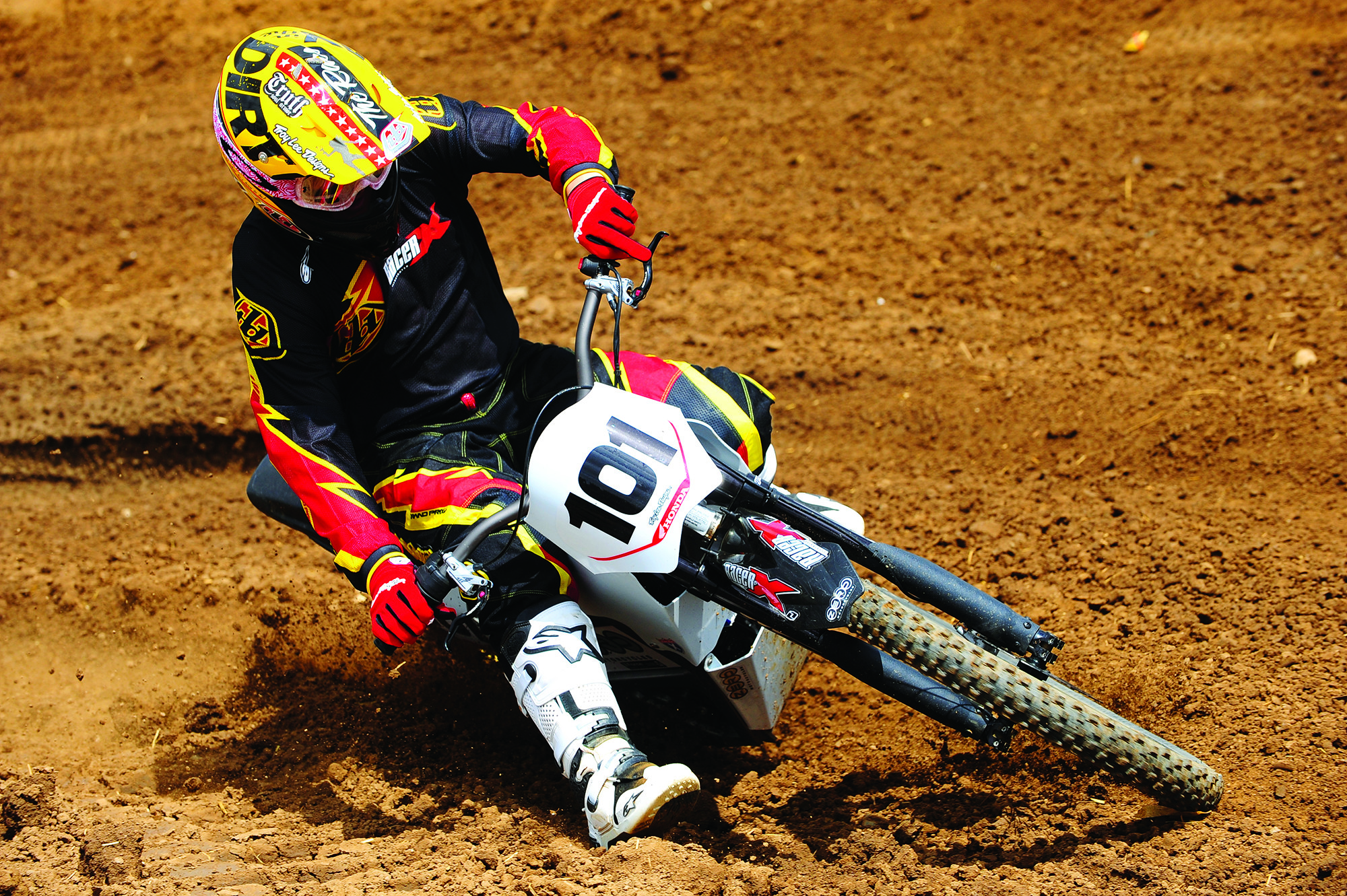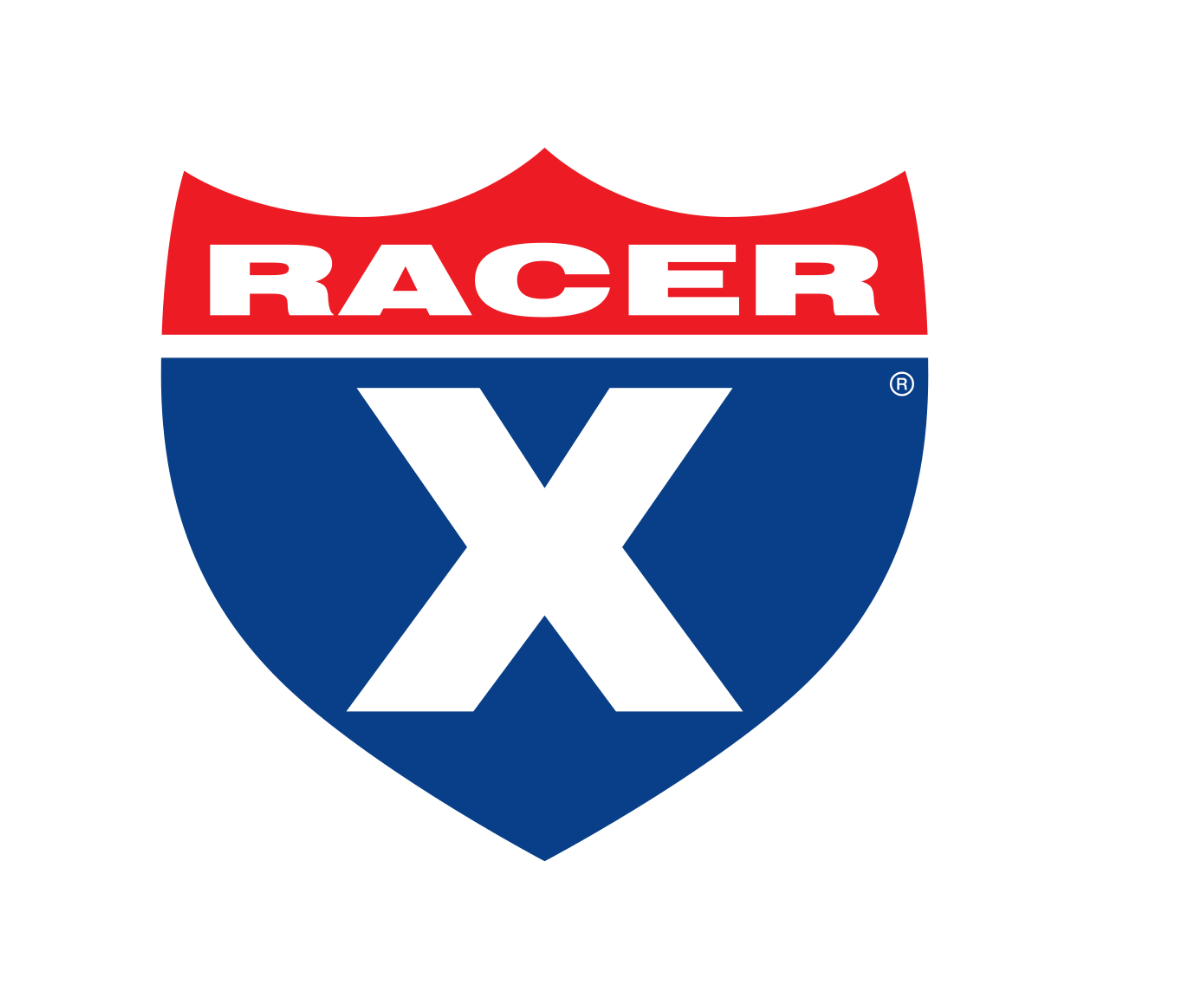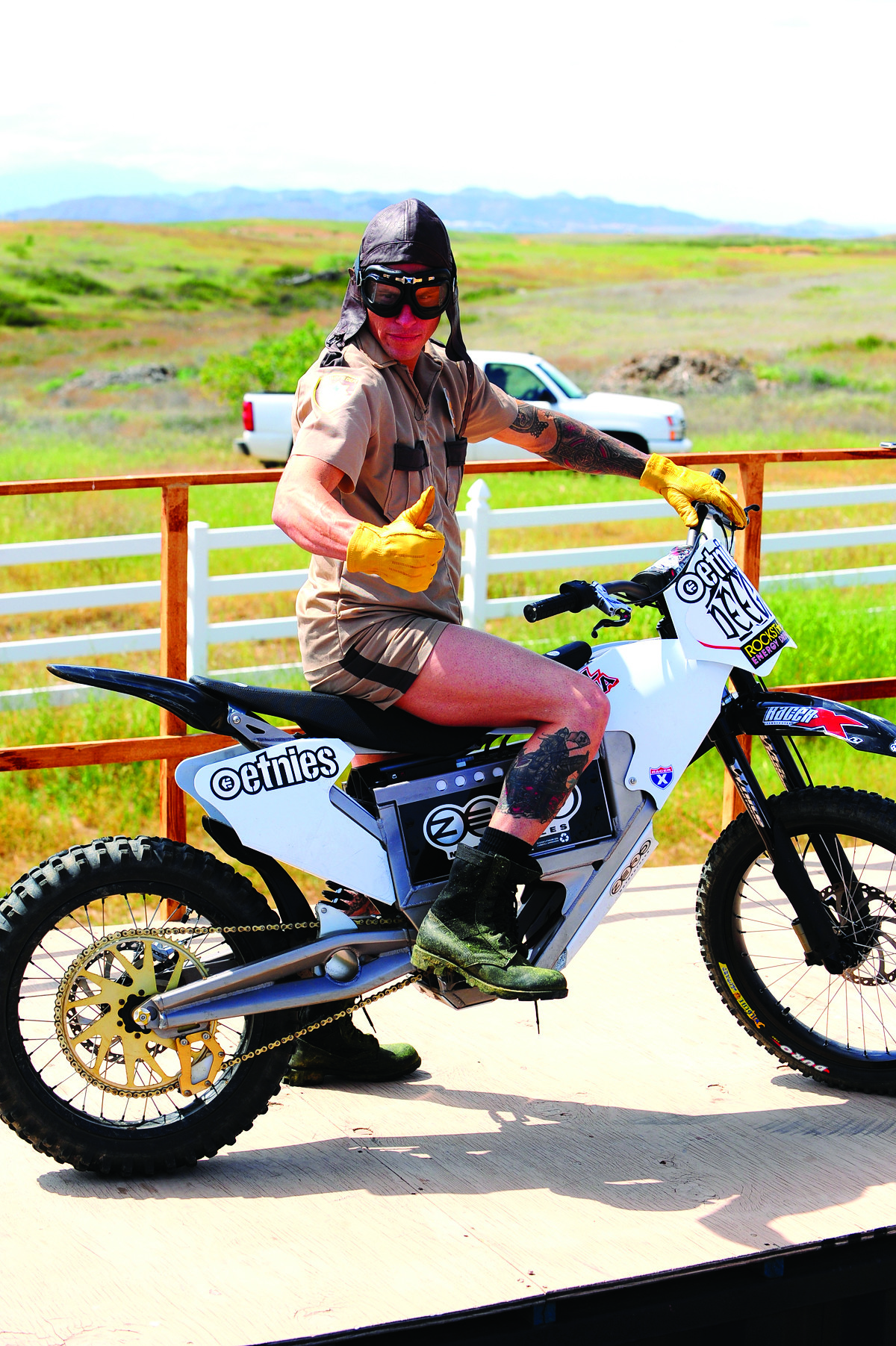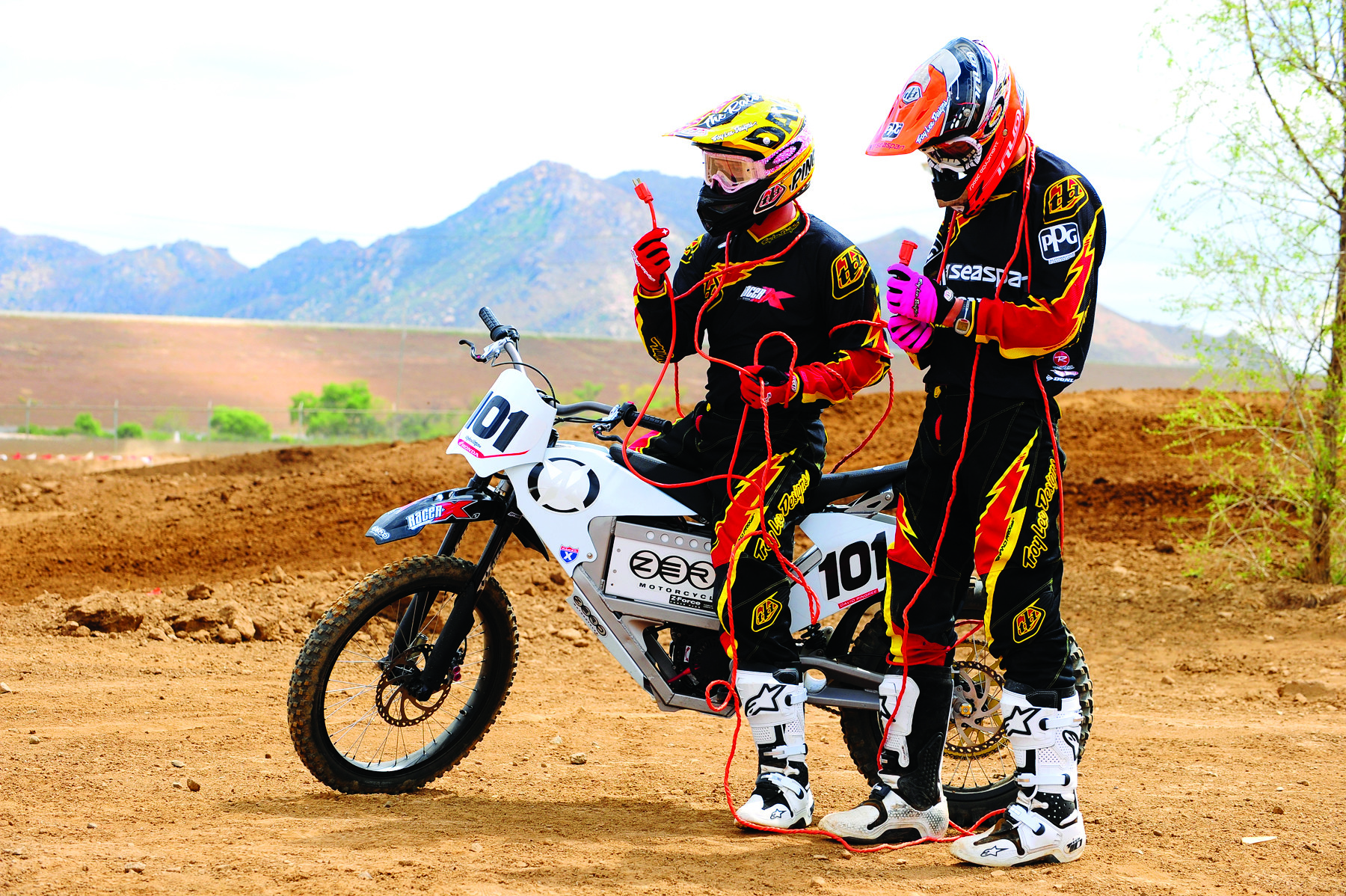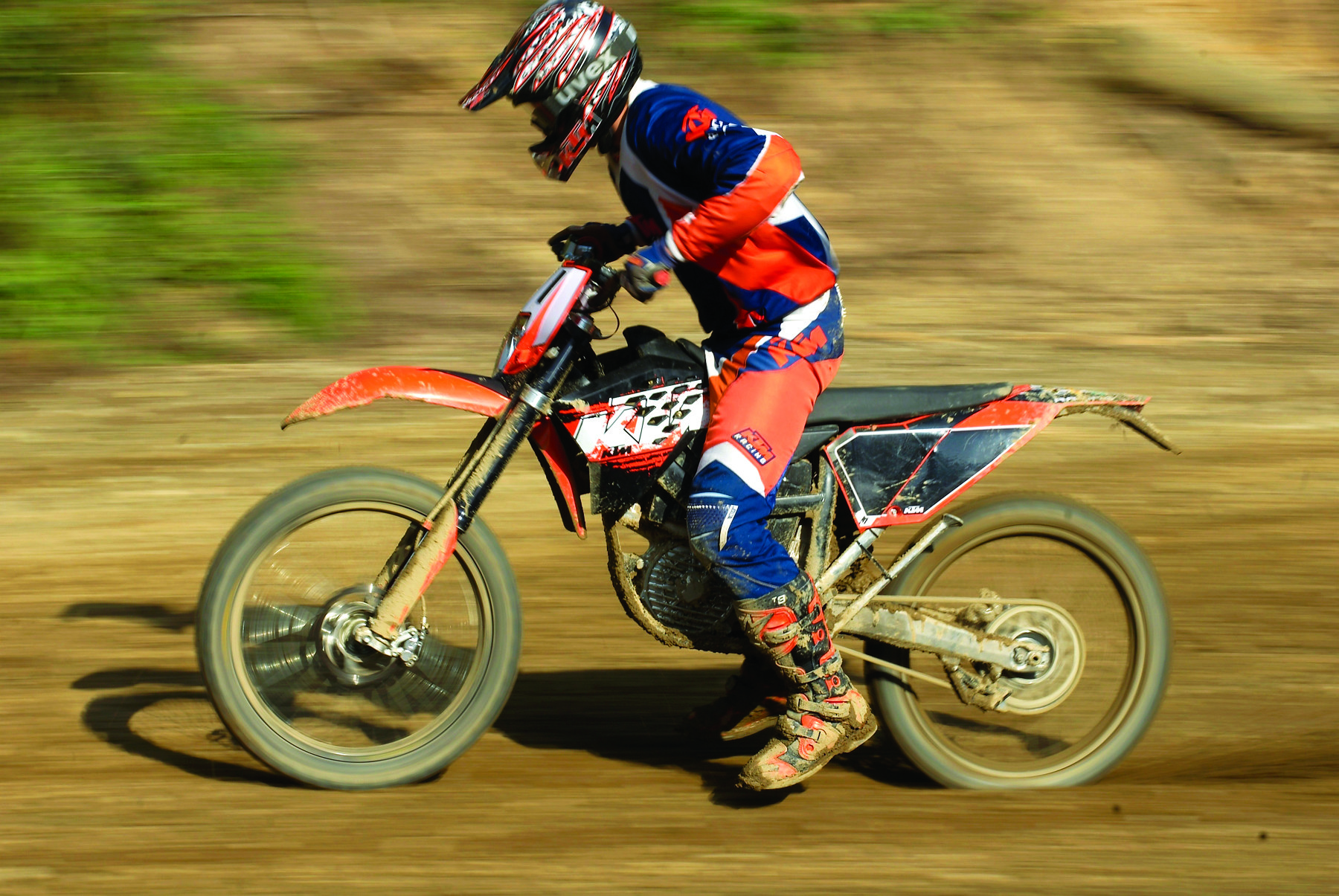With Honda showing off its CR Electric prototype recently, we went and dug out David Pingree's review of the Zero Motorcycle way back in 2009. This story originally appeared in the July 2009 issue of Racer X magazine. You can read the June 2019 issue for no charge right now, right here. Remember to subscribe once you're done.
It is becoming increasingly more difficult to get started in motocross. Think about the way it was when you first began riding. There were several affordable 50cc two-strokes, which made learning to ride very simple; when you outgrew those, there were a dozen more options for the next size, and all of those were readily available. You probably had plenty of places to go ride, too, including open areas that weren't closed-course facilities, like your own back yard. When you were ready for a big bike, you could talk your old man into buying a cheap, used 125 and fixing it up with a top end and a clutch for a reasonable amount of money.
Well, those days are long gone. Today, kids' motorcycles are on the chopping block because of the miniscule-yet-somehow-excessive lead in the frames and brake levers. If they are brave enough to climb on an adult bike (and if they don't get hurt doing it), there is almost a 100 percent chance that it will be a four-stroke. Now, I'm not bashing four-stroke motorcycles; they're great bikes, as long as they don't break. But new bikes cost as much as a compact car, and older models with some time on them are like ticking time bombs waiting to eject engine parts through every side of the crankcase. Once you get to that point, you might as well just throw it away—just like that old wood-framed television with the clicky remote, it will cost you more to fix it than to buy another one.
Some states (Illinois comes to mind) are even trying to pass legislation that will make it illegal for anyone under 16 to ride any type of OHV. Think about it: James Stewart won his first 125cc AMA Supercross 21 days past his 16th birthday. Potentially, future generations wouldn't even be able to get started until they're old enough to drive a car. The ramifications would be catastrophic for the motorcycle industry.
GREEN DAY
Gasoline-powered OHVs have become a target for governments around the globe and right here in the United States. The new buzzword in Washington is green, and anything that flies in the face of that trend, or even appears to, bears a bull's-eye. That doesn't leave motorcycle enthusiasts with a very warm and fuzzy feeling inside—we're guilty of "conspicuous consumption," according to the more radical EC (environmentally correct) people of the world. Not sure what the word is for private jets or diesel motor coaches....
That's not the only problem facing us. As the AMA's Rob Dingman recently said, "The single greatest threat to motorcycling in America—both on-road and off-highway—is excessive exhaust sound." Every motocross or off-road rider should have gotten a chill up their spine when they read that. Four-strokes are louder and their sound carries farther than any two-stroke I ever rode (or at least any two-stroke with an exhaust pipe attached). So, where do we find a bike that isn't loud and isn't a target for conservationists everywhere? A company called Zero Motorcycle based out of Santa Cruz, California, thinks they might have the answer. Their creation is ushering in a new era of motorcycle riding and could change the sport as we know it. It's hard to believe a Zero electric bike weighs only 151 pounds and has 23 horsepower and 50 foot-pounds of torque, but it does. It is powered by a lithium-ion battery that runs anywhere from 45 minutes to two hours when fully charged, depending on usage. It plugs into any standard 110v or 220v outlet and recharges completely in less than two hours. The total cost of operating this bike is $.01 per mile, and it uses zero gas and produces zero emissions or noise. If you're anything like me, you're probably thinking, Hey, those are real nice stats, Captain Treehugger, but how does this bike really work on a motocross track or on an actual trail? That's what I was determined to find out.
QUIET TIME
I recruited a couple of my Troy Lee Designs Honda team riders, Jimmy Albertson and Jake Moss, to beat up on the bikes with me and give their feedback. After a quick stop at Zero headquarters to pick up our machines, it was off to Starwest Motocross Park to shake down our eco-friendly steeds.
The first thing we noticed is the rather small, odd look of the bike. It's taller than a pit bike but noticeably smaller than a 250F. The frame is boxy and rudimentary-looking (hey, it works for Volvo, right?) and the plastics are just terrible. They don't look like they fit the bike at all, and the front number plate looks like it was stolen off of Rick Melon's bike in Winners Take All. The folks at Zero were quick to point out that this model is designed to be a trail bike, not a motocross bike. They also have a street-legal Supermoto version, dubbed the S-Model, which is being marketed as an urban commuter. They will also be releasing a motocross version in the near future. Hopefully, they will also be releasing bold new graphics on the new plastic they have planned for it.
After turning the key and pushing the switch to the faster setting on the handlebars, Jimmy and Jake were off. It's strange to watch a bike go by as fast as this one does without making any noise; I could literally talk to the guys in a normal voice as they rode through a tight corner. Within a few laps, the two TLD riders were jumping most of the obstacles on the track and even passing riders on traditional motocross bikes. Somewhere, Al Gore was crying tears of joy. I wonder how he'd feel if Zero added little loudspeakers on the back fender of this thing to emulate the sounds of a throaty race bike.
MOTO BREAKDOWN
After about 20 minutes, we had a mechanical problem: Jake Moss came up a little short on a pretty decent-sized step-up, and the impact blew about half the spokes out of the rear wheel. The guys all agreed the suspension needed to be stiffer, and after looking more closely at the rear wheel, it was pretty evident that the spokes needed to be upgraded as well. (This model's spokes were actually mountain-bike spokes laced into a motocross-sized rim.) No doubt the motocross version will have heavy-duty spokes to handle the abuse of hard landings.
The Zero staff brought out a new wheel and we were back in business. After we all took turns buzzing around the track (the bike sounds exactly like an RC car), we sat down and downloaded our thoughts. First, Jake was quick to point out that this model needed to be beefier to handle his mistimed jump attempts.
"Straight away, they need to put some bigger spokes in the thing," Moss said in his Australian accent. "For motocross, the suspension is a little soft, mainly on the big jump landings. But it is really fun to ride. The motor pulls good right out of the corners, but once it hits its top speed, it just goes flat." By the way, Zero says the top speed is 60 mph, but it felt a lot more like 30-35 mph to all of us. "I think it needed to be geared a little taller for a track like this because some of the bigger jumps, like the front tabletop, were just a little too long to get over with the current gearing," Moss added. "It would be a blast on a backyard track or something a little tighter with jumps that were sized properly for this bike. I had a lot of fun riding it."
Albertson had similar things to say, albeit with a Midwest twang. "There was a brief hesitation if you rolled the throttle completely off and then back on again, and that was kind of tough to deal with," he explained. "I ended up just leaving it cracked all the time so it was always there. Obviously, the spokes and suspension need to be addressed, just like Jake said. And it needs to be faster. The top speed is too slow to make it useable on a normal motocross track, mostly because of the jumps. If you didn't have any jumps, it might be okay, but it still needs to be quicker. I think there's a lot of potential, though."
I agreed with everything those guys said and voiced my thoughts to one of the Zero technicians. He assured me that the motocross version would be designed for the abuse it would receive on a genuine motocross track. He also reminded me again that this bike was designed and set up for single-track trails and off-road riding. If we had dropped a couple teeth off the back sprocket, it would have gained a significant amount of top speed.
FUN WITH ELECTRICITY!
Our next stop was the Metal Mulisha compound in Temecula. Brian Deegan wanted to see what kind of potential the bike had in the FMX world and, frankly, so did we. Nobody had ever jumped an electric bike into a foam pit before, so we guessed on the ramp distance and even how much throttle to apply when approaching the jump. After deliberating about it for a while and having some serious conversations about the jump and the bike's performance, things got slightly less serious.
The Mulisha general disappeared and then rode up in a spot-on Officer Jim Dangle Reno 911-meets-CHiPs outfit. Then his newest rider, a talented Aussie named Jacko [Jackson Strong], appeared in a Flash costume complete with lightning-bolt ears, a nice tip of the cap to our electrically charged dirt bike. And then Jake Moss, who had tagged along for the FMX segment and wasn't going to be outdone, ran out in what looked to be the outfit Jennifer Lopez wore to the 2005 Grammys or a modified gardening suit. His butt cheeks were hanging out, but he didn't seem to mind.
After we stopped laughing, the bikes started to fly. Deegan made new recruit Jacko jump in first to make sure the distance was right. Then Moss went for his first backflip and did what everyone told him not to do: throw the bike away while he was up-side down. He almost got stabbed by the falling Zero.
Deegan was next, and he threw a 360 backflip before Jacko tried a front flip and then a double backflip. Moss eventually stuck a backflip without ejecting mid-flight, but we were too bothered by his outfit to make a really big deal out of the accomplishment.
The Zero was a hit with the FMX crew. The bike was light and easy to throw around, making it the perfect tool for throwing new tricks into the pit. There was also little or no fire danger, which is a major concern when jumping into the pit on a gasoline-powered bike. (Riders typically shut off their fuel as they head toward the ramp so the carb doesn't continue to drain fuel when it lands in the foam, but the fuel that does spill can easily ignite from the static electricity created between all the foam blocks.) The best part was that the neighbors didn't even know we were there—unless you count the laughter from the top deck of the pit.
"This bike is really fun," Deegan said of the Zero. "It's perfect for messing around in the pit because of the weight and the fact that it doesn't get hot or have gas in it. I'd love to get a few of these to have here at the compound. Man, it would be sick to jump one of these in the Big Air portion of the X Games. They wouldn't even hear you coming!"
RIGHT AT HOME
Our last stop was a well-known mountain-bike trail in Southern California. I had motocross trainer Randy Lawrence join me for this segment because he has experience riding motocross and racing downhill mountain bikes. We shot up an incline that normally takes a while to climb on a bicycle and keeps you right at your anaerobic threshold the entire time. The bike's quick handling and snappy torque made it absolutely perfect for riding trails, though the fact that animals do not hear you coming could prove to be problematic if you ever come across migrating caribou or something.
By the time we reached the summit, Randy and I had ear-to-ear smiles and were laughing about how much fun the Zero was on the trails. Some of the moto guys mentioned that they didn't like the brakes on the handlebars; they wanted the front brake there but wanted the bike to have a right-foot brake pedal. As a mountain-bike traditionalist, Randy wanted the brakes switched from one side to the other (the front is on the right on the Zero while most mountain bikes have the front brake on the left). Still, he got used to it quickly and had nothing but positive things to say about the bike.
"Man, this is a lot of fun," RL offered as his first impression. "You don't expect it to take off the way it does. I guess they make pretty good electric go-karts now, so it makes sense. The only change I would make is swapping the brake levers, which I'm sure could be done pretty easily. Other than that, this thing is awesome. You can tell that it's designed for trails like this, because it works perfectly."
My only complaint is that we were going too fast to notice things like, say, poison oak, which Randy and I were both covered in after our ride. For the next two weeks, I was scratching myself like a crackhead.
AD/DC
Are electric bikes the future of motocross? For me, it's hard to imagine combustion engines being replaced completely. Then again, I never thought I'd be able to clap my hands and make the lights come on in my bedroom. But electric motorcycles are coming, and there's definitely a niche for them. Riding areas are going to continue to disappear, and they aren't coming back. That means more and more people will be forced to ride on their private property and in places closer to homes and businesses that don't like noise. The cool thing is, with everyone on these bikes, you could hold a national in your backyard and your neighbors wouldn't hear it. That opens up a lot of new riding areas for people who like to moto but can't because of noise-including Jeremy McGrath and anyone who used to have a track in Riverside County.
Right now, the Zero electric bike retails for $7,450. That's a pretty good stack of cheddar for most folks. But the technology will get better and the price will eventually come down, especially when there is more competition in the market. Remember how much you paid for your first iPod? Mine was the size of a telephone book and cost as much as a house payment. Now I buy a new one every year because they're so small I keep losing them.
With a few more years of development, Zero or even another current motorcycle manufacturer could produce a bike that very nearly mimics a modern motocross bike. I really believe that. Sure, I believed in the Tooth Fairy for an unusually long time, but what do you expect when I'm getting cold, hard cash for molars and incisors? Electric motocross bikes? Welcome to the future.
Sidebar: ORANGE + GREEN = MORE RIDING AREAS?
Another manufacturer hard at work on an electric off-road motorcycle is KTM. Earlier this year, photos were leaked showing the Austrian manufacturer having a test session with Bader Manneh, a Californian who long ago emigrated to Italy. The shots were a little grainy, but the message was clear: KTM is moving forward with electric-motorcycle development. The bike looks cool, and the photos got a lot of people asking when it would be out. I called Kurt Nicoll, KTM's head of U.S. racing, to find out.
“The bike is completed, as far as the prototype stuff goes," Nicoll said. "We've done quite a bit of testing, and it's a project we're very excited about. They're saying that the bike is very similar in feel and power to a very fast 80cc two-stroke or even a stock 125. That's impressive for an electric motor. And there are still many advances to be made in the way of batteries. Right now it’s using a lithium-ion battery that is the best of its kind. But with the way technology is advancing in that market, it could be 200 percent better and smaller in the next two years.”
Asked about the purpose or intent of the bike, Nicoll was clear with his answer. "This is being developed right now as an off ‘road bike,’" he replied. "In Europe, the riding areas are much fewer than they are here. It's nearly impossible to find a place to ride in Germany, Austria, and many other countries because of noise. This bike will allow riding again for many people who just ran out of places to ride. This same thing is happening her in America, and we want to have a bike that makes noise a non-issue. This bike is built as an off-road bike because that's the market hat it is needed in right.
"But it will be durable enough to be a motocross bike,” he added. "And in time, I'm sure we will have a motocross version that is basically the same with a few different features."
Production on the bike isn't likely to stall any time soon, given the economic climate. But when the time comes, KTM will be ready to race.



